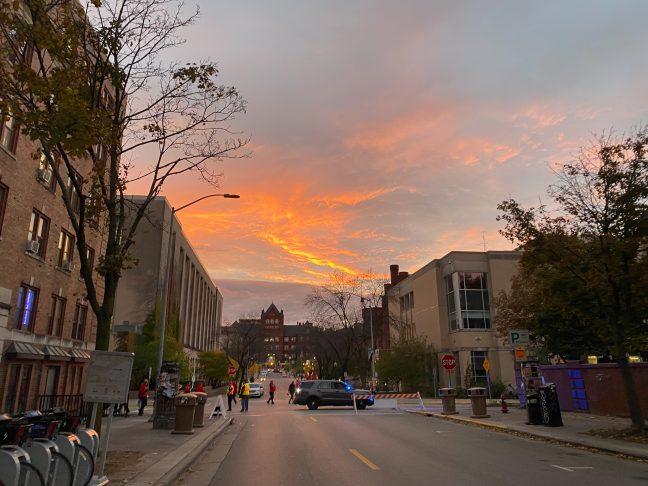Spectrum News 1 reported in late October that some young people are moving to the Great Lakes region to escape the effects of climate change.
It is not the first time the Midwest — particularly Madison — has been labeled a ‘climate haven.’ While the region still faces issues like higher temperatures and increased precipitation, the Midwest has a lot of freshwater sources and is generally spared from natural disasters.
University of Wisconsin professor Jack Williams, the director of the Center for Climatic Research, said Madison’s location makes it less susceptible to disasters facing cities in other parts of the U.S.
Climate change is affecting Wisconsinites’ health, new UW study finds
“The Upper Midwest might be a little more naturally climate-resilient,” Williams said.
Spectrum News interviewed John Anderson and Sarah Neujahr, a couple who moved from the Denver, Colorado metropolitan area for a new life in Madison. The couple cited how forest fires and pollution were affecting their mental and physical health.
These effects and others are projected to get worse. NOAA released a time series to visualize the cost of climate and weather disasters in the U.S. since 1980. Adjusted for inflation, the costs of natural disasters in 2020 were about $100 billion. The five-year average cost of these disasters has increased from $16.3 billion in 1984 to $140.7 billion in 2020.
Williams said that regions like the Driftless Area in western Wisconsin contain microclimates — also called areas of variability — that allow species to move around when temperatures rise or fall. This is due to changes in elevation or differences in tree cover.
The Nature Conservancy said that the Great Lakes region has a variety of climate-resilient areas in which biodiversity can thrive. The Conservancy said that Wisconsin’s Kettle Moraine corridor includes a variety of biomes for animals to travel between.
Madison featured as ‘climate-haven’ in CBS segment on climate refugees
But Williams said climate change still poses a threat to the Madison area. Though the Upper Midwest is thought to be less susceptible to droughts and forest fires than other parts of the country, Williams said his research on ancient tree populations suggests otherwise.
Williams said there is evidence that local tree populations from past millennia could have been damaged by hot and dry conditions. Hot and wet conditions also posed a threat.
“As the world gets warmer, the air can hold more water in it and that can mean bigger rain events, more powerful hurricanes and big floods and so forth,” Williams said.
Expert of weather and climate variability Stephen Vavrus said climate change increases the frequency of slow-moving storms around the region. Current models might not accurately predict an increase in the frequency of other storms like hail storms and tornadoes, but Vavrus said Madison is expected to flood more and more in the coming decades.
Heavy rainfall resulting in flooding would not be unprecedented for the Isthmus. For example, Williams said 15 inches of rain fell within a 24-hour span during a 2018 rainstorm in the Dane County area.
Varvus’s research found that precipitation around the Madison area has steadily increased every year since the mid-1900s. This increase correlates with a similar change in local temperatures.
Climate change apparent in warmest, wettest decade ever recorded in Madison
The Wisconsin State Journal reported in 2018 that the rainstorm Williams referred to was the heaviest rainfall in Wisconsin’s history.
Another Wisconsin State Journal article, published the next year, said damages from the flooding cost $154 million. In response, local governments allocated $34 million to invest in major flood prevention projects.
Civil and environmental engineer Kenneth Potter said the destructive flooding made all the city governments in Dane County rethink their vulnerabilities.
“You can have a big event like the one you referred to, due to a huge amount of rainfall in a short amount of time, that’s one kind of flood event,” Potter said. “But the Yahara Lakes don’t flood as a result of one event. The Yahara Lakes integrate runoff over a long period of time.”
The Yahara Lakes are several bodies of water connected by the Yahara River, including Lake Mendota. Potter explained that higher water levels overall make flooding more likely from one storm.
Potter said that urban development exacerbates rainfall-runoff and Dane County developers have to change how they construct buildings and roads to be more sustainable. Methods such as subsoiling and putting in runoff volume controls can help this happen.
Potter also said there has been pushback from developers and builders that don’t want to spend money on meeting these regulations.
Groundwater flooding is an issue that isn’t widely recognized in Madison or around the world, according to Potter. As groundwater levels rise due to climate change, buildings constructed in low elevations will be damaged by swelling water.
So even as some individuals flock to Madison as a Midwest climate sanctuary, whether the Upper Midwest’s climate-resilient strengths will outweigh its weak points remains to be seen in Madison.














